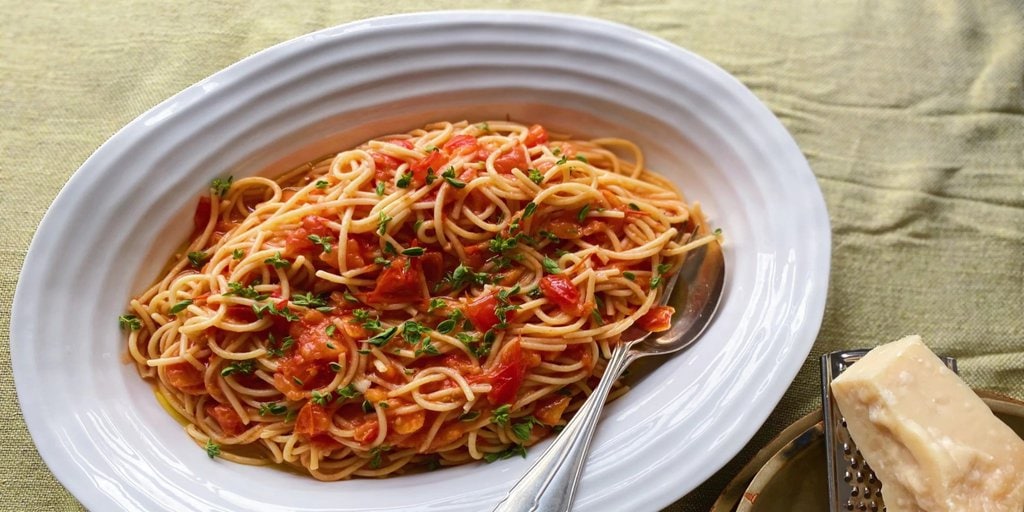A great way to utilize cherry tomatoes is by transforming them into uncomplicated pasta dinners. The remarkable combination of tomatoes, garlic, Parmesan, basil, and pasta will certainly spark anyone’s culinary curiosity. The tomatoes in this recipe are not cooked and make up a quintessential pasta sauce for the summer season.
Pasta With No-Cook Tomato Sauce

The brilliance behind this method lies in allowing the cooked pasta’s residual heat to gently warm the tomatoes, preserving their fresh, raw, garden-fresh flavor. The recipe accommodates the use of either halved cherry tomatoes or large tomatoes. Before mashing the tomatoes, it is essential to squeeze out any excess water to prevent an overly runny or watery sauce. Once all the ingredients are combined, the sauce should be covered and refrigerated for up to eight hours. Preparing the sauce in the morning and allowing it to meld until dinner time is optimal, but even a 15-minute resting period will suffice.
After the sauce has had ample time to come together, it is advisable to taste and adjust the flavor to accommodate the varying levels of sweetness and acidity in the tomatoes. Additional honey, balsamic vinegar, or fresh lemon juice can be added as necessary, and it is possible to enhance the sauce with briny and salty ingredients such as minced anchovies, capers, or chopped olives, but such additions are not obligatory. Also, the chunks of butter will melt when combined with the cooked pasta, resulting in a luxuriously glossy sauce.
Ripe Tomatoes Work Best

It is important to note that this particular pasta sauce is not intended for reheating. Therefore, it is recommended to prepare only the amount that will be consumed. The recipe can be halved or doubled according to individual needs.
Preparation Time: 20 minutes Cooking Time: 10 minutes Total Time: 30 minutes
Ingredients: 2 pounds ripe heirloom tomatoes, halved 3/4 cup finely grated Parmesan 1 clove garlic, grated 3 tablespoons extra virgin olive oil 4 tablespoons unsalted butter 1 zested and juiced lemon 1 teaspoon honey 1 teaspoon balsamic vinegar 1 teaspoon kosher salt 1/2 teaspoon crushed red pepper flakes 1/2 teaspoon freshly ground black pepper 1 pound long pasta 1 1/2 cups torn basil leaves
Cut the tomatoes so the excess water, seeds, and innards get released into a bowl. Discard these elements and chop the tomato into 1-inch pieces. Use a wooden spoon to crush the tomatoes.
Add the garlic, Parmesan, butter, olive oil, lemon juice and zest, balsamic vinegar, honey, red pepper flakes, salt, and black pepper to the mashed tomatoes and mix the ingredients. Cover with plastic wrap and let it rest for 15 minutes.

Bring a salted pot of water to a boil and cook the pasta until it reaches the desired texture. Transfer the cooked pasta directly into the bowl with the tomato mixture. Taste the pasta and season accordingly with additional salt and black pepper. Incorporate the basil, and the pasta should be ready for serving!
The Pros and Cons of No-Spend Challenges When it Comes to Finances
Even people who have a good understanding of their finances may find themselves questioning where their money goes. The urgency of this question is further heightened during times of economic turmoil, where a rise in living expenses and little to no increase in income results in a struggle to reconcile the disparity between their budgets and bank accounts.
 Monitoring Finances Shouldn’t Be Abused
Monitoring Finances Shouldn’t Be Abused
With limited opportunities to save on necessities such as utilities and food, people are seeking inventive ways to cut down on their expenses. These days, “no spend challenges” have emerged as a popular trend. Individuals aim to abstain from spending on non-essential items for a week, a month, or even longer while tracking their progress on social media, which makes frugality almost enjoyable.
While this is alarming, building good habits regarding finances, such as savings, can promote better financial practices in an approachable manner. Some technology companies have even incorporated game-like features and challenges, such as setting aside money every time it rains or establishing specific targets, to keep users engaged.
Saving Money Should Be Rational
Although saving money is beneficial, the no-spend trend can be problematic, and this is evident in its similarities to crash dieting. The weight loss industry has contributed to long-lasting psychological damage related to food, and the same disordered relationship with money can potentially be caused by no-spend challenges. By examining the trend on Instagram, it becomes apparent that there are many familiar themes that mirror the culture of starvation diets. These include color coding, with green indicating good days and red indicating bad days, self-criticism by individuals who purchase a new toothbrush, and critical or tough-love comments from others.
Similar to the discomfort experienced when eating unhealthily during a diet, spending can cause physical and psychological unease during a no-spend challenge. Just as a diet promises an easy solution to a complex problem, the no-spend challenge offers a simple fix with the click of a button. Despite all that, there is a positive side to being mindful of spending habits. It can increase self-awareness and prevent impulsive purchases that often result in anxiety and remorse. Sharing one’s spending habits with thousands of people can promote accountability, foster meaningful conversations, and provide a sense of solidarity through comments. This engagement can keep individuals motivated to continue saving and offer illuminating insights in various ways.
 Rational saving can make a person feel more connected with their money and put more focus on how to stay in control of finances. It certainly is the first step of an ongoing process rather than a simple test done through a challenge based on deprivation and punishment. So, while challenges can be fun and saving is necessary, it can be said that no-spend challenges that go too far can have a detrimental effect and should be replaced with rational personal financial policies.
Rational saving can make a person feel more connected with their money and put more focus on how to stay in control of finances. It certainly is the first step of an ongoing process rather than a simple test done through a challenge based on deprivation and punishment. So, while challenges can be fun and saving is necessary, it can be said that no-spend challenges that go too far can have a detrimental effect and should be replaced with rational personal financial policies.
